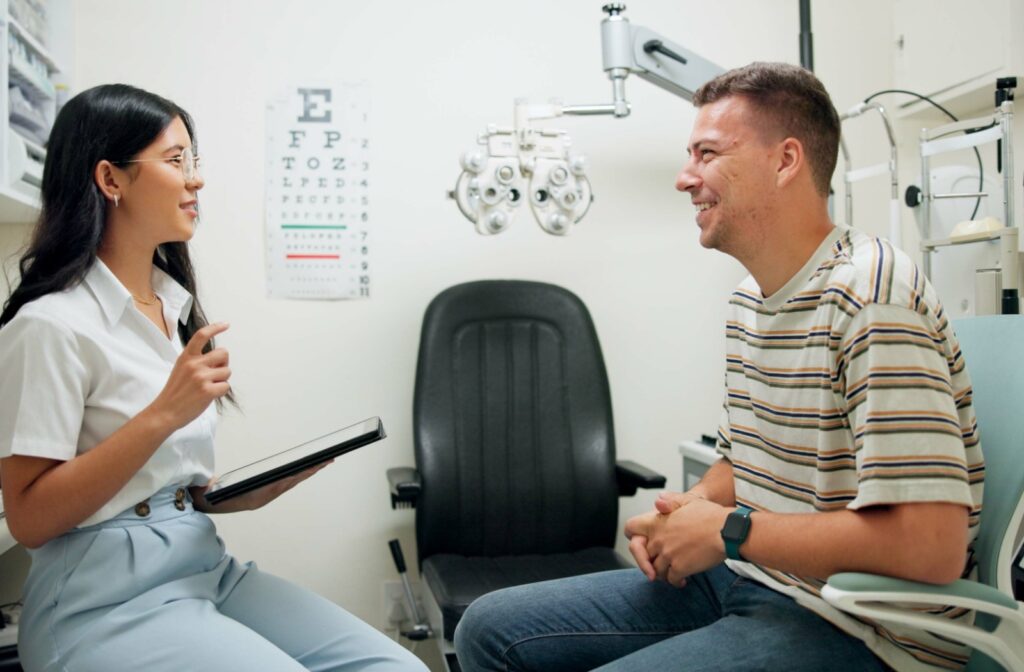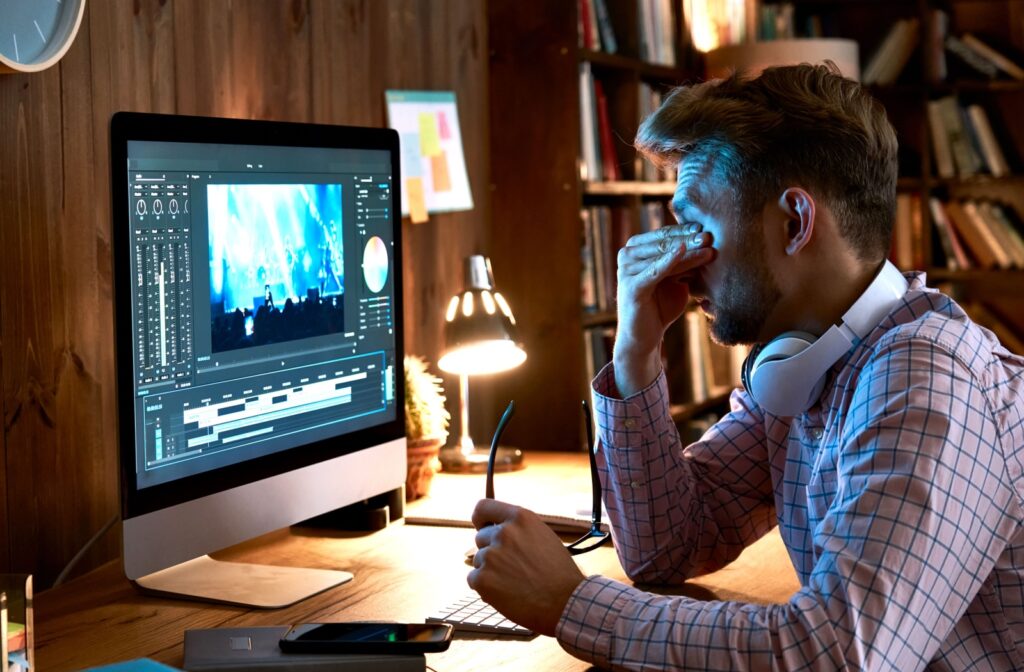If you’ve spent hours staring at a screen, experienced that dull ache behind your eyes, or struggled to focus, you’re not alone. Eye strain is a growing problem in our tech-driven world. Between remote work, social media scrolling, and streaming marathons, we’re exposing our eyes to screens more than ever.
Eye strain is temporary and begins to subside once you’ve taken a break from focusing on your task. Sometimes, the symptoms may linger for several hours or days.
However, if eye strain persists for weeks or longer, this may indicate an underlying concern.
Luckily, there are several effective ways to prevent and manage eye strain. A thorough evaluation from your optometrist can help find the most suitable solution for your unique visual needs.
How Long Does Eye Strain Last?
Eye strain occurs when your eyes are overworked, often from prolonged close-up focus work like reading without breaks, prolonged screen use, or working under poor lighting conditions.
A common misconception is that only people who require the support of corrective lenses experience eye strain, but this isn’t the case. Eye muscles can strain and fatigue in anyone.
Its symptoms often include:
- Blurry vision
- Headaches
- Dryness
- Light sensitivity
Eye strain usually resolves on its own within several hours after taking a break from work or resting your eyes for several hours. However, the strain can linger for a couple of days or weeks, which might signal an underlying issue.
Recovery from eye strain can vary from an hour to several, and days or longer, depending on several factors, including:
- Screen time: Spending hours on end staring at a screen without taking breaks is one of the leading causes of prolonged eye strain. Screen use reduces how frequently you blink, leading to dryness and irritation, and worsening eye strain symptoms. The more you use screens, the longer it may take for your eyes to recover.
- Lighting conditions: Straining your eyes under dim lighting or exposure to excessive glare worsens the problem. Poor contrast between your screen and the surrounding environment can also increase eye fatigue.
- Underlying vision problems: Uncorrected vision issues, such as astigmatism or farsightedness, can exacerbate eye strain symptoms by forcing your eyes to work harder. A routine eye exam can diagnose and treat this underlying concern.
- Posture and screen position: A poorly positioned monitor—too high, too low, or too close—can force your eyes to work harder, delaying recovery.
- Hydration and humidity: Dry eyes are a common symptom of strain, and prolonged screen time makes it worse. Low-humidity environments (like air-conditioned offices) can amplify this effect, slowing the healing process.
- Chronic health conditions: Certain health issues, such as migraines or dry eyes, can mix with digital eye strain, leading to longer discomfort.

Introducing Neurolenses
Some people’s eye strain may persist despite taking extra precautions through preventive measures. Fortunately, effective advanced solutions, such as Neurolenses can offer some much-needed relief.
Neurolenses are specialized optical lenses designed to alleviate strain, headaches, and discomfort caused by digital screen use and other near-vision tasks. They incorporate a unique contoured prism technology that addresses the root cause of many discomforting visual symptoms.
One potential reason some people may experience ongoing eye strain is binocular misalignment. It’s a condition where your eyes struggle to work together as a pair, causing them to send slightly conflicting signals to your brain. This can create extra strain as your visual system works harder to compensate, especially when focusing on nearby objects like screens.
Neurolenses help realign your vision by incorporating a contoured prism into their design. This promotes smoother, more natural eye coordination, reducing strain on your muscles.
Here’s how Neurolenses can help:
- Less eye strain: They ease the workload on your eyes, reducing eye fatigue also related to prolonged screen time.
- Fewer headaches: Many users reported experiencing fewer tension headaches and neck pain.
- Improved focus: Neurolenses simultaneously correct vision and encourage proper eye alignment, improving overall comfort, performance, and productivity.
These specialized eyeglass lenses are ideal for people experiencing chronic eye strain or discomfort that isn’t improved by traditional eyewear. However, they may not be necessary for everyone.
Here’s who Neurolenses will benefit the most:
- Professionals who spend hours on computers or other screens daily.
- People who experience frequent headaches or neck pain related to eye strain.
- People with undiagnosed binocular vision issues.
Consult your optometrist if you’re interested in Neurolenses. They’ll conduct specific tests to determine if these eyeglasses are right for you.
Tips for Preventing Eye Strain
Although eye strain often develops as a consequence of prolonged work many of us cannot avoid, small lifestyle changes can help prevent it and speed up recovery:
- Follow the 20-20-20 rule: This simple rule is a life-saver for screen users. Every 20 minutes, look at something 20 feet away for at least 20 seconds. This gives your eye muscles a chance to relax, reducing the risk of strain.
- Adjust your screen setup: Place your screen about an arm’s length away (20-24 inches) with the top of the screen at eye level to combat poor posture. You can reduce glare from the monitor by using anti-reflective screens. Keep your workspace well-lit without harsh overhead lighting.
- Invest in computer glasses: Specially designed computer glasses with anti-reflective and magnification properties can significantly reduce eye strain. These glasses are tailored to the intermediate distance of computer screens, helping to minimize focusing fatigue and provide clearer, more comfortable vision during long work sessions.
- Remember to blink: We tend to blink less when focused on computer work, which worsens dryness and discomfort. Make a conscious effort to blink more often while working at a computer.
- Take regular breaks: Give your eyes (and the rest of you) some downtime by stepping away from your screen every hour or so. Stretch, move around, or spend a few times gazing out the window.
- Stay hydrated and use artificial tears: Drinking plenty of water (at least 8 glasses for adults) helps prevent dryness. Consider using artificial tears to hydrate your eyes to prevent worsening eye strain.
Experience Visual Comfort
Eye strain doesn’t have to be the norm in our digital world. Proactive measures like Neurolenses and preventative strategies can help safeguard your sight. If persistent eye strain is something you’re struggling with, contact our Eye Care Plus team to schedule an appointment. Together, we can work to find the right solution for your visual needs!



